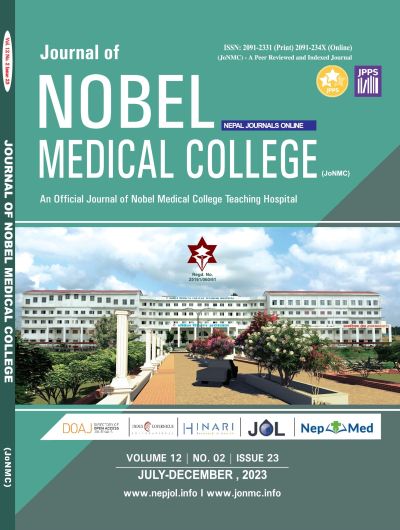Computed Tomography Assessment of Linear Splenic Dimensions and their Correlation with Anthropometric Measurements in Nepalese Population
DOI:
https://doi.org/10.3126/jonmc.v12i2.61472Keywords:
Body mass index, Body surface area, Nepal, SpleenAbstract
Background: Geographical locations and ethnicity may influence variations in normal spleen dimensions, potentially leading to errors in assessment. This study aimed to correlate splenic dimensions with anthropometry and predict their variation with age and body surface area.
Materials and Methods: Subjects (n=384) undergoing abdominal computed tomography were selected by random sampling. Splenic volume was calculated using the standard prolate ellipsoid equation. Correlation of splenic volume with body surface area and body mass index was done with Pearson’s correlation analysis. A multiple regression was run to predict splenic volume from age, height, and body surface area.
Results: The mean age was 45±18 (range, 18-90 years). The mean splenic length, width, thickness, and volume were 7.6 ± 1.7 cm, 8.8 ± 1.5cm, 3.8 ± 0.9 cm, and 139 ± 58.2 cm3, respectively. The splenic width and splenic volume were significantly lower at extremes of age. A significant (P<0.05) correlation was seen between splenic volume, body surface area(r=0.393) and body mass index (r=0.126); a negative correlation was observed between splenic volume and age (r=-0.180). Splenic dimensions were significantly larger in males. Multiple regression revealed that an increase in body surface area (by 10 cm2), predicted increased splenic volume was 4.3 cm3. An increase in age (by 1-year), predicted decrease in splenic volume was 8.3 cm3. For 10 cm increase in height, predicted increase in splenic volume was 1.7cm3.
Conclusion: The study showed a positive correlation between splenic volume and body surface area, as well as body mass index and provides a crucial normative data for assessing splenic enlargement in Nepalese population.
Downloads
Downloads
Published
How to Cite
Issue
Section
License
Copyright (c) 2023 Crystal KC, Bikash Bikram Adhikari, Rakshya Parajuli

This work is licensed under a Creative Commons Attribution 4.0 International License.
JoNMC applies the Creative Commons Attribution (CC BY) license to works we publish. Under this license, authors retain ownership of the copyright for their content, but they allow anyone to download, reuse, reprint, modify, distribute and/or copy the content as long as the original authors and source are cited.




